Understanding Your Electrical Panel Upgrade Investment
The average 100 amp panel upgrade cost ranges from $850-$1,500 including materials and labor. If you’re replacing an existing 100-amp panel with a new 100-amp panel, expect to pay $1,200-$1,800. For a full upgrade from 100 amps to 200 amps, costs typically run $1,300-$3,000 depending on your location and existing wiring.
| Type of Upgrade | Average Cost Range |
|---|---|
| Upgrade existing 100-amp panel | $850-$1,500 |
| Replace with new 100-amp panel | $1,200-$1,800 |
| Upgrade from 100 to 200 amps | $1,300-$3,000 |
| Add a 100-amp subpanel | $500-$1,500 |
Your home’s electrical panel is the central hub that distributes power throughout your property. Think of it as the heart of your electrical system – when it’s undersized or outdated, everything from your appliances to your lighting can suffer. Many homes built before the 1990s came with 100-amp service, which was sufficient for the limited number of electrical devices typical of that era. But today’s homes run multiple high-powered appliances, electronics, and possibly even electric vehicle chargers, putting significant strain on older systems.
If you’re experiencing frequent breaker trips, flickering lights, or buzzing sounds from your panel, these are warning signs that your electrical system is struggling to keep up with demand. Upgrading your panel isn’t just about convenience—it’s a critical safety investment that can prevent electrical fires and ensure your home’s systems operate efficiently.
I’m Jesse Burnett, Master Electrician and founder of Dr. Electric CSRA, and I’ve personally overseen hundreds of panel upgrades with 100 amp panel upgrade costs ranging from simple replacements to complex whole-home electrical renovations. My team and I have the expertise to guide you through every step of your electrical panel upgrade, ensuring safety, code compliance, and reliability.
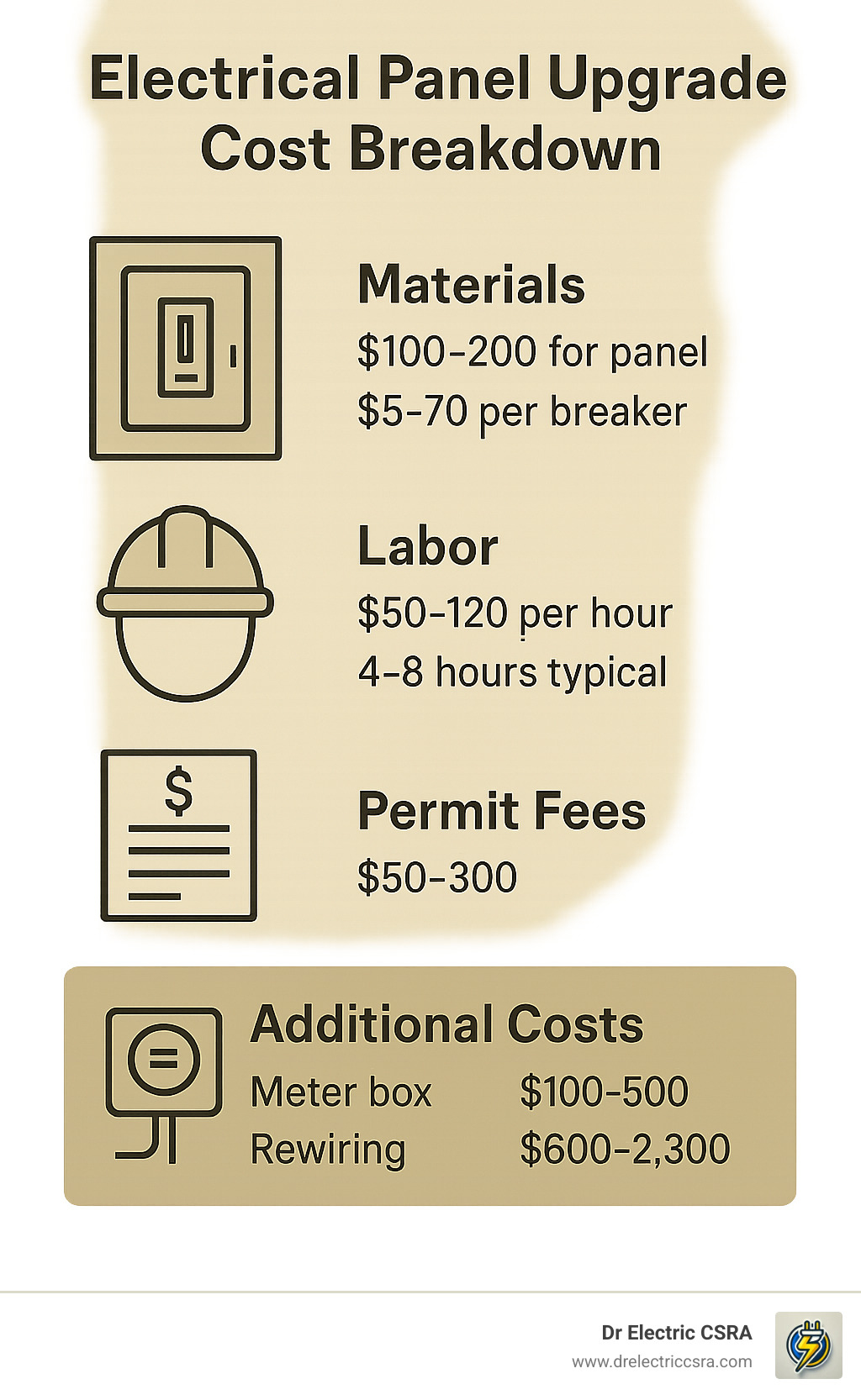
100 amp panel upgrade cost further reading:
Why 100 Amps May No Longer Be Enough
Remember when homes only needed power for a refrigerator, washing machine, and a few lights? Those days are long gone! When 100-amp service became the standard in the 1960s and 70s, most households ran just a handful of appliances. Today, our homes are buzzing with technology and power-hungry devices that our grandparents couldn’t have imagined.
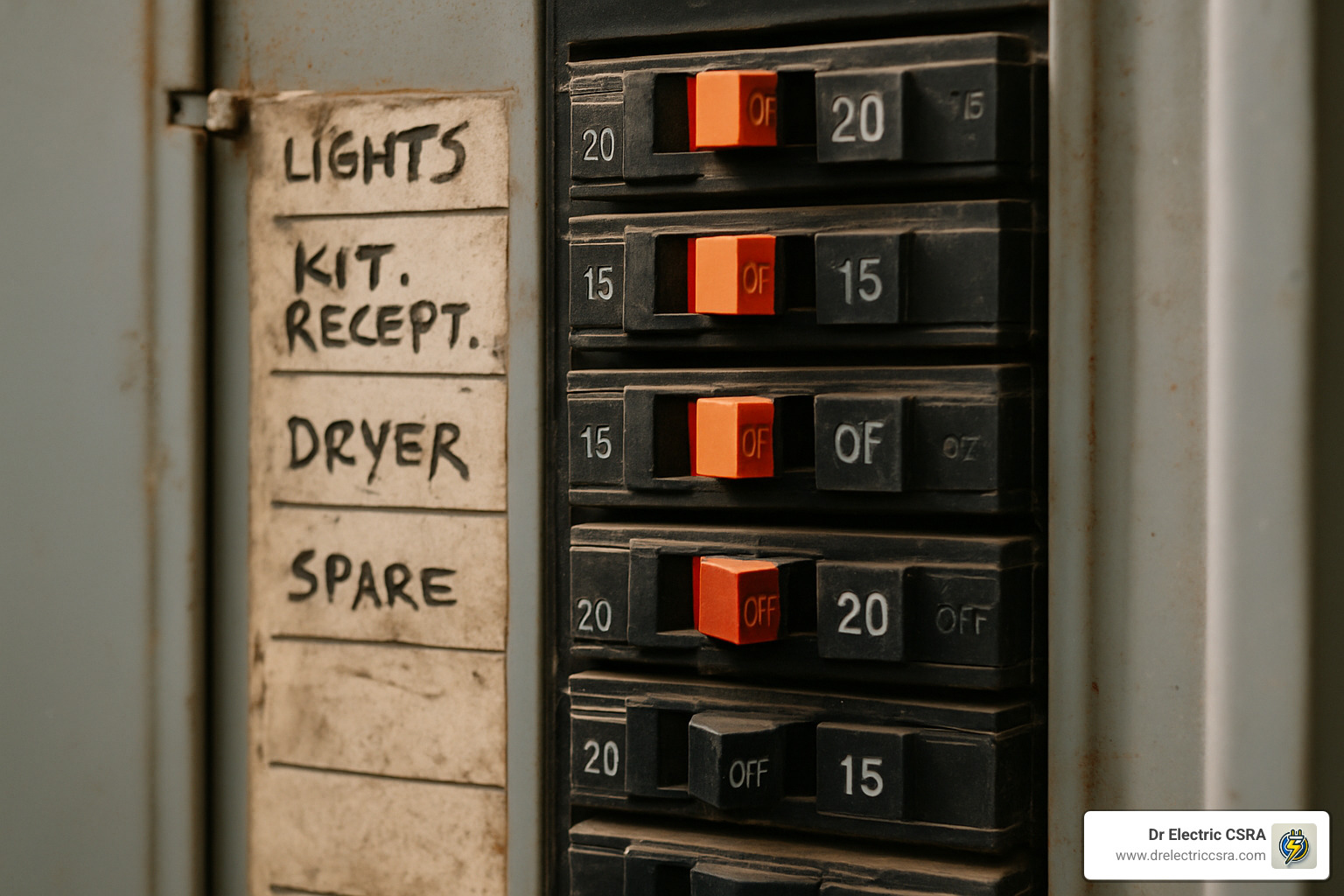
Your 100-amp panel delivers about 24,000 watts of power (100 amps × 240 volts). That might sound like plenty, but let’s get real about what modern life demands:
Your electric range alone needs 30-50 amps. Add a central air conditioner (30-40 amps), water heater (25-30 amps), and clothes dryer (25-30 amps), and you’re already pushing the limits. Now imagine adding an EV charger that needs another 30-50 amps! Suddenly, that 100-amp service doesn’t seem so generous.
When your home’s electrical appetite exceeds what your panel can safely deliver, you’ll notice the signs: breakers tripping frequently, lights dimming when the AC kicks on, or finding yourself unable to run the microwave and toaster at the same time. These aren’t just annoyances – they’re your electrical system waving a red flag.
The safety concerns are serious. The National Fire Protection Association reports that electrical failures cause nearly 47,000 home fires each year, leading to hundreds of deaths and over $1.5 billion in property damage. An undersized panel struggling to meet demand creates real risk.
For homeowners embracing electrification – switching to heat pumps, induction cooking, or charging an electric vehicle – a 100-amp panel often simply can’t keep up. While careful planning might let you electrify on 100 amps, most modern homes need at least 200 amps to handle today’s needs and tomorrow’s technologies.
How a 100-Amp Panel Works
Think of your electrical panel as your home’s power gateway. Power comes in from the utility through the service drop (those wires running from the pole to your house). Inside your panel, main lugs receive this power and distribute it through circuit breakers to individual circuits throughout your home.
The “100 amps” rating is essentially your home’s power budget – the maximum current that can safely flow through your system at once. This limit is determined by your main breaker size, the internal bus bars, and the service entrance cables.
Electricians determine if your panel is adequate through a load calculation that considers:
Your home’s square footage, appliance types and quantities, heating and cooling systems, and future expansion plans. When your actual usage approaches or exceeds that 100-amp rating, you’re risking system overload, which can lead to overheating, damaged wiring, and potential fires.
Signs Your Panel Is Undersized or Unsafe
Beyond simply being too small for your needs, many older 100-amp panels may have serious safety issues. Here are the warning signs that should prompt immediate attention:
Visible damage like burn marks or corrosion on the panel should never be ignored. If you hear buzzing or crackling sounds coming from your panel, that’s your electrical system telling you something’s wrong. A panel that feels warm to the touch or emits a burning smell demands immediate professional inspection.
Frequent breaker trips when running normal household loads indicate your panel can’t keep up. If you still have an old fuse box instead of circuit breakers, you’re missing out on important modern safety features.
Certain brands like Federal Pacific Electric, Zinsco, or Pushmatic have known safety defects. And regardless of brand, panels older than 25-40 years often need replacement simply due to wear and degradation of components.
Don’t gamble with electrical safety. If you spot any of these warning signs, it’s time for a professional assessment. At Dr. Electric CSRA, we provide thorough electrical safety inspections to identify potential hazards before they turn into emergencies. Your family’s safety is too important to leave to chance when it comes to your 100 amp panel upgrade cost investment.
100 amp panel upgrade cost: Price Breakdown
Let’s talk dollars and cents – because I know that’s what you’re really wondering about. When it comes to upgrading your electrical panel, understanding the full cost picture helps you budget properly without any nasty surprises. The 100 amp panel upgrade cost varies throughout the Augusta, GA and CSRA region, but I can give you a clear breakdown of what to expect.

Detailed 100 amp panel upgrade cost Breakdown
1. Panel and Materials Cost
The panel box itself is just one piece of the puzzle. For a typical upgrade, your materials will include:
The actual 100-amp panel unit runs about $100-$200, which might surprise you – it’s not the biggest part of your investment. Then there are the circuit breakers: standard ones cost $5-$20 each, while those special AFCI or GFCI breakers (which modern code requires for bedrooms, kitchens and other key areas) will set you back $35-$70 each.
Don’t forget the wiring and connectors ($100-$300 depending on your home’s setup) and possibly a new meter base ($100-$300) if yours is outdated.
2. Labor Costs
This is where the bulk of your 100 amp panel upgrade cost comes from – and for good reason. Working with your home’s electrical heart isn’t a DIY project!
Here in Augusta and the CSRA area, licensed electricians typically charge between $50-$120 per hour. A standard 100-amp panel replacement usually takes 4-8 hours of skilled work. The more circuits your home has, the longer it takes to transfer everything safely to the new panel.
3. Permits and Inspections
I can’t stress this enough – proper permits aren’t optional! They typically run $50-$300 depending on where you live in the CSRA region. Most permit fees include the required inspections, but sometimes you might need to pay extra if multiple inspections are necessary. This step ensures your upgrade meets all safety codes.
4. Comparison of Upgrade Options
| Service Size | Panel Only | Full Installation | Timeline | Best For |
|---|---|---|---|---|
| 100 Amp | $100-$200 | $850-$1,800 | 4-8 hours | Small homes, limited appliances |
| 150 Amp | $150-$250 | $1,000-$2,200 | 5-10 hours | Medium homes, moderate electrical needs |
| 200 Amp | $200-$350 | $1,300-$3,000 | 6-12 hours | Larger homes, multiple appliances, EV charging |
I’ve found that most homeowners in our area are better off upgrading directly to a 200-amp service rather than replacing with another 100-amp panel. Yes, it costs $500-$1,200 more upfront, but you’re getting double the electrical capacity, which future-proofs your home and often increases its value. It’s usually the smarter long-term investment.
Hidden 100 amp panel upgrade cost Add-Ons
Now let’s talk about those potential surprise costs that can catch you off guard if you’re not prepared:
Your service entrance cable might need upgrading if it’s not rated for your new panel’s capacity. This can add $600-$2,300 depending on length and accessibility. It’s like buying a powerful new engine but keeping old fuel lines – sometimes the whole system needs to match.
If your current panel sits in a location that violates modern code (like inside a bathroom or closet), relocating it can add $1,000-$2,700 to your project. Older meter sockets often need upgrading alongside the panel, adding another $100-$500.
Homes with outdated wiring may need additional circuit work. Rewiring costs typically run $6-$10 per square foot, while adding new circuits costs $150-$500 each. And once walls are opened up, we sometimes find issues that weren’t visible before – damaged wiring, improper grounding, or water damage. I always recommend budgeting an extra 10-15% as a contingency for these unexpected repairs.
At Dr. Electric CSRA, we pride ourselves on providing detailed, transparent quotes that account for all foreseeable costs. We’ll walk through your home and identify potential issues before work begins, helping you avoid those heart-stopping surprise expenses. After all, electrical work should shock your system, not your wallet!
Stretching Your Budget: Incentives, Subpanels & Smart Alternatives
Let’s face it – electrical upgrades aren’t cheap. But before you worry about the 100 amp panel upgrade cost, let me share some good news: there are several smart ways to make your upgrade more affordable without cutting corners on safety or functionality.
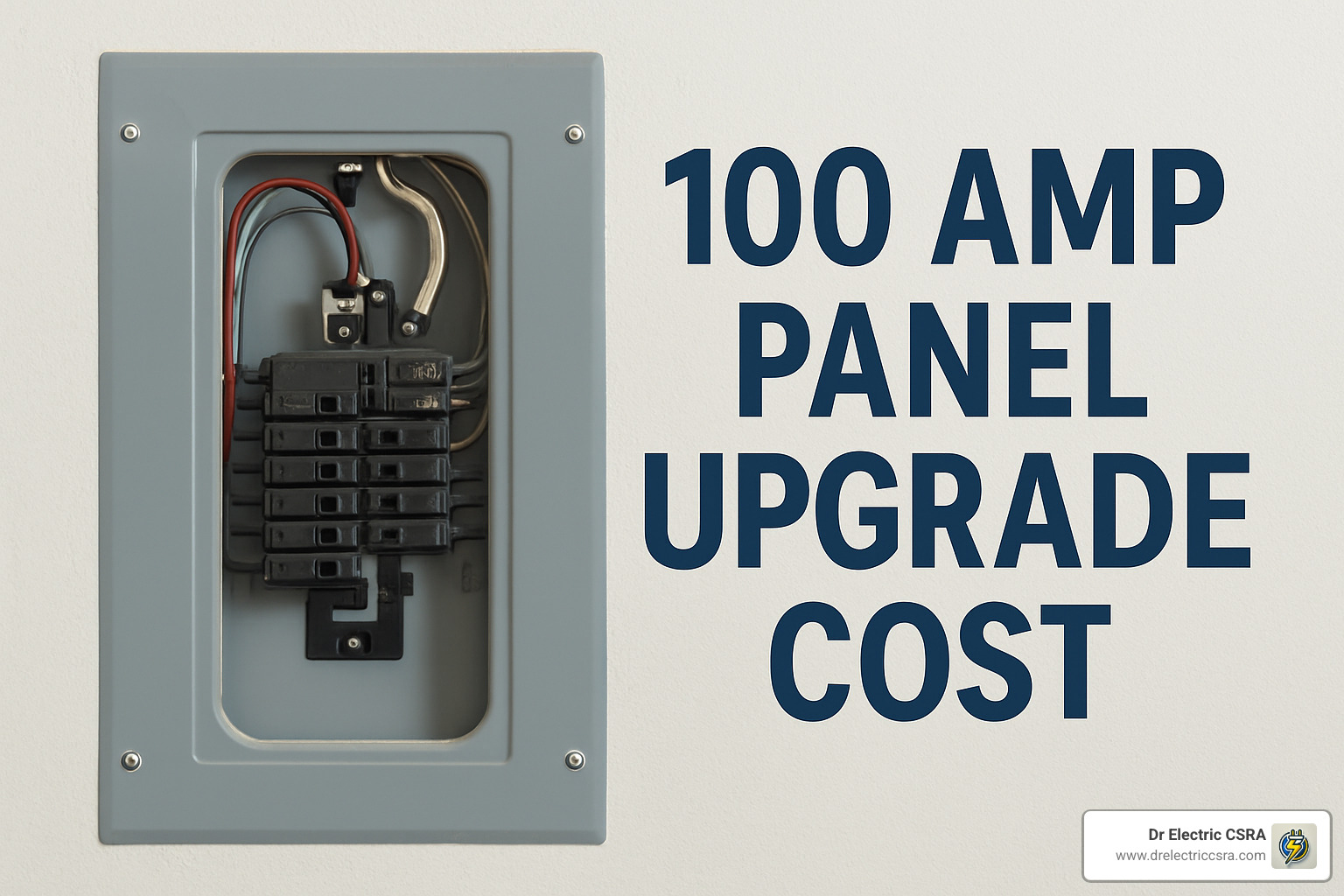
Can a 100-Amp Subpanel Solve the Problem?
Sometimes, a full service upgrade isn’t necessary – adding a subpanel might be the perfect solution for your needs and your wallet.
Think of a subpanel as adding an extension to your electrical system rather than replacing the whole thing. For many Augusta homeowners I’ve worked with, this approach makes perfect sense when:
You simply need more circuit spaces but your overall power usage stays under 100 amps. Many older panels have limited breaker slots that fill up quickly.
You have a specific area with high electrical demand, like a workshop, garage, or home addition. Placing a subpanel closer to where you need the power improves efficiency and can be more cost-effective than running multiple long circuit runs.
Your main panel is in good condition but full. Why replace what’s working? A subpanel gives you room to grow at $500-$1,500 installed – roughly half the cost of a full 200-amp upgrade.
You want dedicated circuits for specific needs like an EV charger or home office without disrupting your existing setup.
However, a subpanel isn’t always the answer. If your home regularly pushes the limits of your 100-amp service, or if you’re planning to add major electrical loads like heat pumps or multiple EV chargers, you’ll likely need a full upgrade to 200 amps. And of course, if your existing panel shows any safety concerns (like those burn marks or buzzing we discussed earlier), replacing it should be your priority.
Another innovative option worth considering is a smart load management system. These high-tech panels monitor your electrical usage in real-time and can automatically prioritize certain circuits during peak demand. They’re pricier ($1,500-$4,000 installed) but might help you “stretch” your existing service by preventing overloads. For tech-savvy homeowners, the ability to monitor and control your electrical usage from your smartphone is an added bonus!
Rebates & Tax Credits to Offset Costs
Uncle Sam and various agencies want to help you upgrade your electrical system – seriously! Taking advantage of available incentives can significantly reduce your 100 amp panel upgrade cost.
The Inflation Reduction Act (IRA) is a game-changer for homeowners considering electrical upgrades. It provides a federal tax credit covering 30% of your panel upgrade costs (up to $600) when installed alongside qualifying energy-efficient improvements. This credit is available through 2032 with no income restrictions. I’ve helped dozens of customers steer this process to claim their rightful savings.
Local incentives sweeten the deal even further. Georgia Power offers several rebates for energy efficiency upgrades, and some local jurisdictions provide permit fee reductions for safety-related electrical work. Every dollar saved counts!
Don’t overlook utility company programs either. Many offer special incentives or even on-bill financing with minimal interest rates for panel upgrades. This can transform a large upfront expense into manageable monthly payments.
For households with qualifying incomes, the savings can be even more substantial. The IRA’s Home Electrification and Appliance Rebates program offers up to $4,000 for panel upgrades to income-qualified households through state energy offices.
At Dr. Electric CSRA, we stay up-to-date on all available incentives and can guide you through the application process. We’ve seen these programs cut customers’ out-of-pocket expenses by 20-40% in many cases. Why pay more when these programs are specifically designed to help homeowners like you upgrade safely and affordably?
For detailed information about available incentives, check out this scientific research on electrification without upgrades. And while you’re planning your panel upgrade, consider adding surge protection to safeguard your valuable electronics and appliances.
Getting the Job Done: Timeline, Permits & Choosing an Electrician
Once you’ve decided to upgrade your panel, understanding the process helps ensure a smooth project from start to finish.
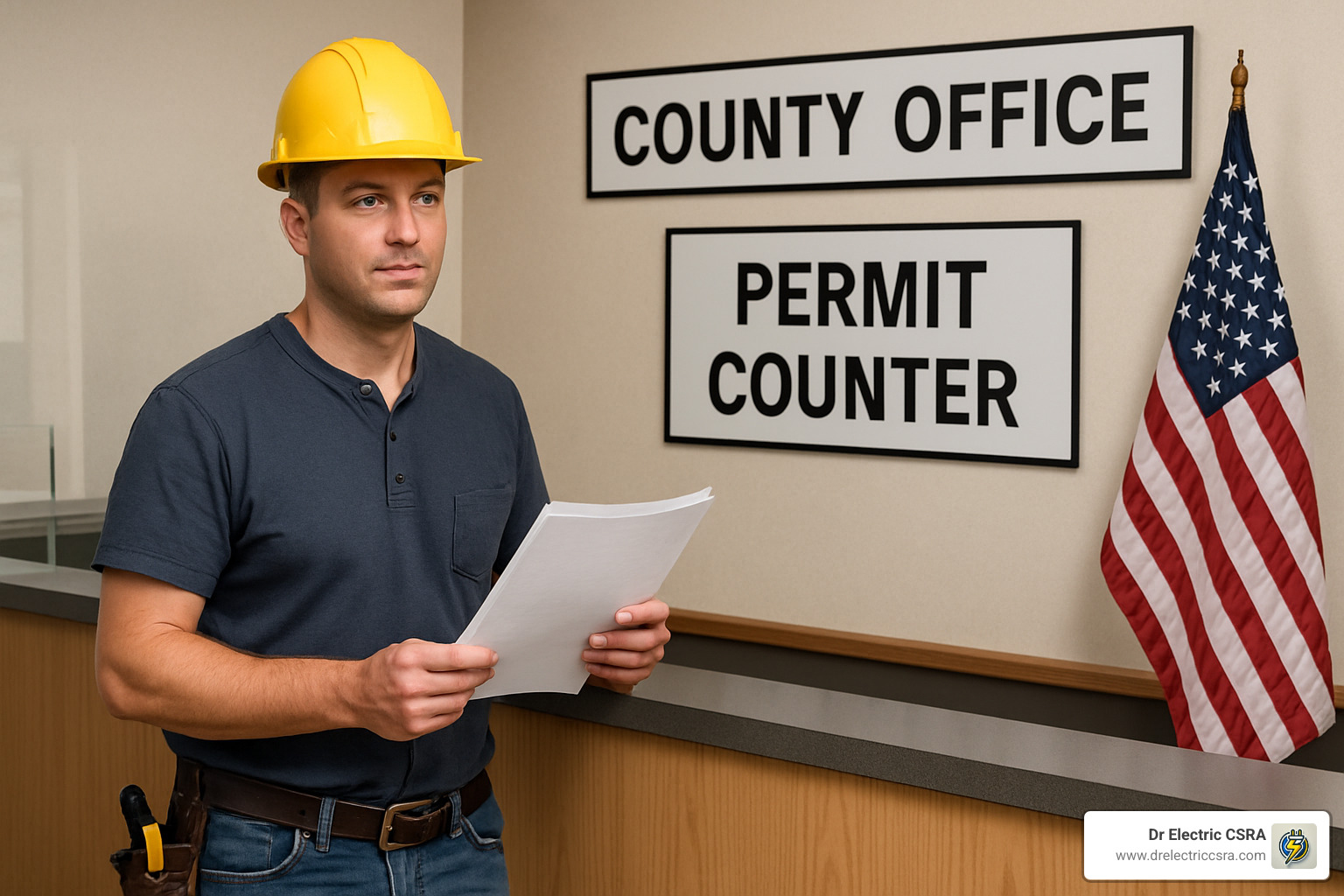
Let me walk you through what to expect when upgrading your electrical panel. The journey typically begins with an initial consultation and estimate (usually taking 1-2 days), where we’ll assess your home, perform a detailed load calculation, and provide you with a clear written quote.
Next comes the permitting phase (3-10 days), where your electrician handles all the paperwork with the local building department. Don’t worry about navigating this bureaucracy yourself—at Dr. Electric CSRA, we manage this step for you completely.
The third step involves utility coordination (1-7 days). We’ll schedule both the disconnection and reconnection with your utility company, ensuring minimal disruption to your daily life.
The big day arrives with the actual installation (typically 4-12 hours). We’ll disconnect power, carefully remove your old panel, install the new one, reconnect and clearly label all your circuits. Many homeowners are surprised at how smoothly this process goes when handled by professionals.
After installation comes the inspection (usually 1-5 days later), where a local building inspector verifies everything meets code requirements. Sometimes minor adjustments are needed, but we’ll handle those promptly.
Finally, power restoration happens, typically the same day as inspection approval. The utility company reconnects your service, and we perform final testing on all circuits to ensure everything works perfectly.
From start to finish, the entire process typically takes 1-3 weeks, though this can vary depending on permit processing times and utility company scheduling in the Augusta area.
How to Select the Right Pro
Choosing the right electrician is crucial for a safe, code-compliant panel upgrade. Your home’s electrical system isn’t something to entrust to just anyone with a pair of wire strippers.
First, verify proper licensing and insurance. Any electrician working on your panel should have a valid Georgia state electrical license, carry liability insurance, and have workers’ compensation coverage. Don’t be shy about asking to see these credentials—reputable pros expect it.
Experience matters tremendously when it comes to panel upgrades. Ask potential electricians how many similar projects they’ve completed and request references from recent customers. Photos of previous work can also tell you a lot about their attention to detail.
When reviewing quotes, look for clear, detailed information. A professional estimate should include itemized costs, explain the permit and inspection processes, provide a realistic timeline, and outline warranty coverage. Vague quotes often lead to unexpected costs later.
Code knowledge is non-negotiable. Your electrician should be fluent in both the National Electrical Code (NEC) and any local amendments. They should be able to explain these requirements to you without resorting to confusing jargon.
Pay attention to their communication style during your initial interactions. Do they respond promptly? Can they explain technical concepts clearly? Do they listen to your concerns? These early interactions often predict how the entire project will go.
At Dr. Electric CSRA, our team ticks all these boxes. We’re fully licensed, insured, and have completed countless panel upgrades throughout Augusta and surrounding areas. We believe in clear communication and transparent pricing, so you’ll always understand exactly what you’re paying for.
Project Timeline From Quote to Power-On
Understanding what happens on installation day helps you prepare and reduces anxiety about the process.
Before the big day, there are several things you can do to ensure everything goes smoothly. Clear access to your electrical panel by removing any stored items within 3 feet. Back up sensitive electronic equipment and make arrangements for the temporary power loss (typically 4-8 hours). Some homeowners find it helpful to have a cooler ready for refrigerated items, especially during Georgia’s warmer months.
On installation day, the process begins when the utility company disconnects power at your meter. Our electricians then carefully remove the old panel, mount and connect the new one, and properly label all circuits. We pay special attention to grounding and bonding—critical safety components that inexperienced electricians sometimes overlook.
After installation, we thoroughly test all circuits to ensure everything works correctly. The local building inspector will verify code compliance, after which the utility company restores your power. Finally, we provide you with complete documentation of the work performed, which can be valuable for home sales or insurance purposes.
At Dr. Electric CSRA, we’ve refined this process to minimize disruption to your daily life. We plan thoroughly, work efficiently, and keep you informed every step of the way. Our goal is always to restore your home’s power as quickly as possible while ensuring the highest standards of safety and quality.
The 100 amp panel upgrade cost is certainly an investment, but with the right professional handling your project, it’s an investment in your home’s safety, functionality, and future value. For more information about electrical repairs and how we can help, visit our Electrical Repair page.
Frequently Asked Questions about 100 amp panel upgrade cost
How long does a 100-Amp upgrade take?
When homeowners ask me about timing, I tell them there are two answers – the actual hands-on work and the complete process. The installation itself typically takes my team just 4-8 hours of focused work. But the full journey from decision to finished project usually spans 1-3 weeks.
Why the difference? We need to obtain permits, coordinate with your utility company for disconnection and reconnection, and schedule the final inspection. At Dr. Electric CSRA, we handle all this coordination for you, minimizing disruptions to your daily life and keeping you informed at every step.
Do I need a full 200-Amp service or will a subpanel do?
This is one of the most common questions I hear, and the honest answer is: it depends on your specific situation. If your total electrical demand regularly pushes beyond what 100 amps can handle, or if you’re planning additions like EV charging, a heat pump, or hot tub, I typically recommend upgrading to a full 200-amp service.
On the other hand, if you simply need more circuit spaces or want dedicated circuits in a specific area (like a garage workshop), a subpanel might be the perfect solution. The best way to know for sure is to have us perform a professional load calculation that accounts for all your current and planned electrical needs. This isn’t guesswork – it’s a precise mathematical assessment of your home’s requirements.
Will the upgrade increase my home’s resale value?
Yes, upgrading your electrical panel typically boosts your home’s value, though I should be upfront that it’s not always a dollar-for-dollar return on investment. That said, a modern 200-amp panel makes your home significantly more marketable by addressing a common inspection concern, providing capacity for today’s appliances and technologies, and demonstrating that you’ve maintained your home properly.
I regularly hear from real estate professionals throughout Augusta and the CSRA region that homes with updated electrical systems sell faster and face fewer inspection objections. Many potential buyers (especially those who’ve dealt with older homes before) specifically look for upgraded electrical systems, and some insurance companies even offer lower rates for homes with modern panels.
What’s the difference between replacing and upgrading a 100-amp panel?
This distinction confuses many homeowners, so let me clarify. Replacing a 100-amp panel means installing a new 100-amp panel in place of your old or damaged one. This improves safety and reliability but doesn’t increase your home’s electrical capacity. It’s like getting a new engine of the same horsepower for your car.
Upgrading means increasing the service size, typically to 200 amps, which both improves safety and substantially increases your available power – like switching from a 4-cylinder to an 8-cylinder engine. The 100 amp panel upgrade cost reflects this difference: a straight replacement typically runs $850-$1,500, while a capacity upgrade to 200 amps costs $1,300-$3,000.
Can I install a panel myself to save on costs?
I understand the appeal of DIY to save money, but I have to be completely honest here: attempting to install your own electrical panel is dangerous and potentially fatal. Electrical panels involve working with high voltage that can cause serious injuries if mishandled.
Beyond the immediate safety risks, improper installation can create fire hazards, violate electrical codes, void your home insurance coverage, and fail inspections. The potential consequences far outweigh any cost savings. This is one project that should always be performed by licensed, insured electricians who know local codes inside and out.
How do I know if my current panel is unsafe?
Your electrical panel might be quietly showing warning signs of trouble. Watch for frequent breaker trips or blown fuses, which indicate your panel is struggling to handle your electrical demands. Flickering lights when appliances turn on or buzzing sounds from the panel are also red flags.
Be especially concerned if you notice a warm panel cover or breakers, any burning smell near the panel, or visible rust, corrosion, or burn marks. If your home has a panel manufactured by Federal Pacific, Zinsco, or Pushmatic, these brands have known defects that pose serious safety concerns.
Age is another important factor – panels older than 25-40 years often need replacement regardless of apparent condition. If you notice any of these warning signs, please don’t wait – contact us immediately for a safety inspection.
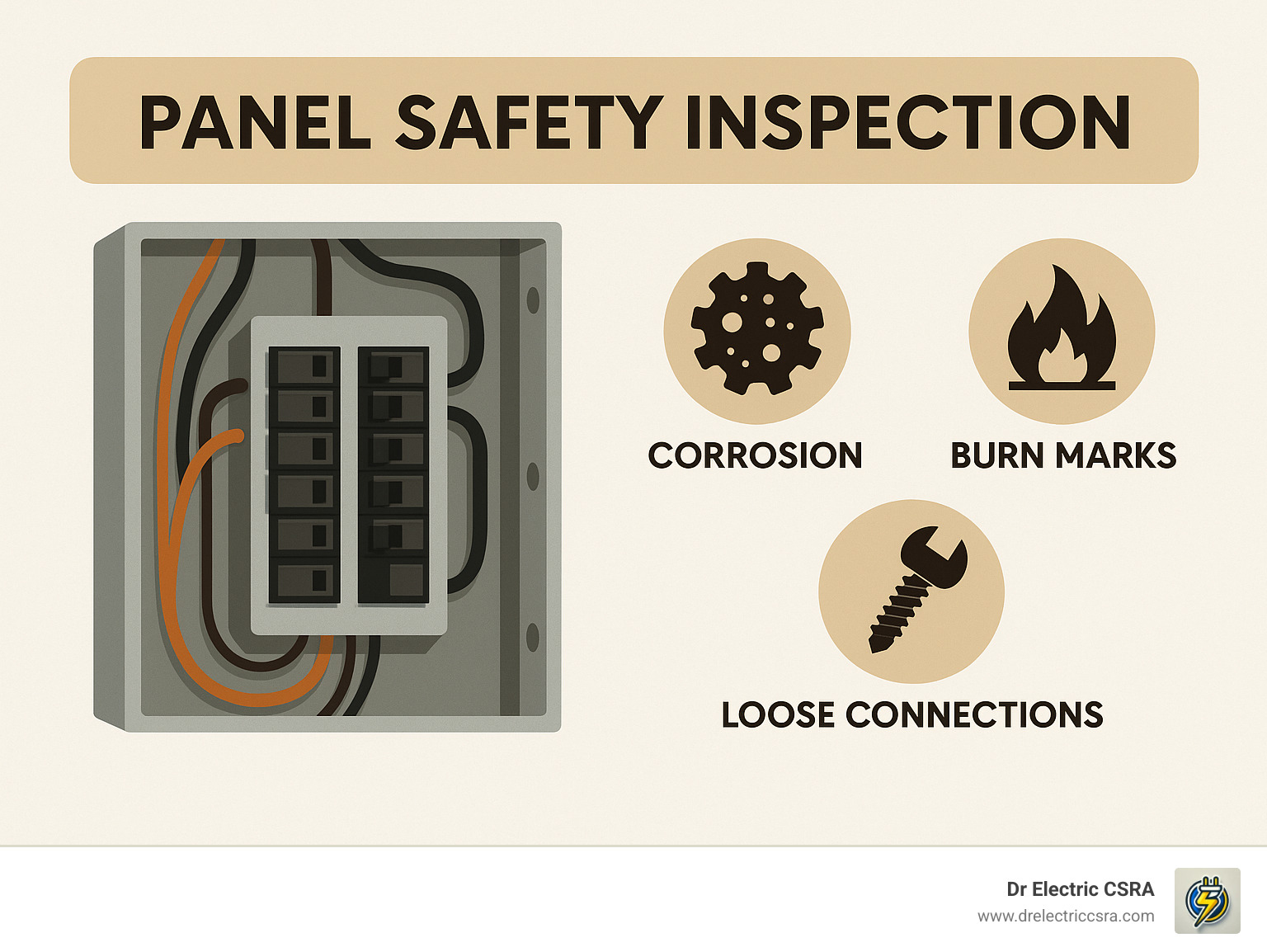
Conclusion
Upgrading your electrical panel is one of the most important investments you can make in your home’s safety and functionality. While the 100 amp panel upgrade cost might seem significant at first glance, it’s a small price to pay compared to the potential costs of electrical fires, damaged appliances, or the daily frustration of living with an inadequate electrical system.
Here in Augusta and throughout the CSRA region, homeowners typically invest between $850-$1,500 for a standard 100-amp panel replacement, or $1,300-$3,000 for an upgrade to 200 amps. These figures generally cover everything you need – materials, labor, permits, and inspections – though your home’s unique configuration might require some additional work.
At Dr. Electric CSRA, we’re not just installing metal boxes with switches – we’re providing peace of mind. Our licensed, experienced electricians ensure your new panel is installed correctly, meets all code requirements, and provides the capacity your modern lifestyle demands. We take pride in doing things right the first time, because your family’s safety is too important for shortcuts.
We understand that every home tells its own electrical story. That’s why we offer personalized consultations to determine the best solution for your specific needs and budget. Maybe you need a simple panel replacement, or perhaps a full service upgrade would better serve your growing electrical demands. Some homes benefit most from adding a subpanel. Whatever your situation, we’ll provide clear, upfront pricing and expert installation without the technical jargon or surprises.
Don’t wait until those flickering lights or frequent breaker trips evolve into a middle-of-the-night electrical emergency. Contact Dr. Electric CSRA today for a free panel inspection and upgrade quote. Our friendly team serves Augusta, Evans, Grovetown, Martinez, and the entire CSRA region with prompt, professional electrical services delivered with a smile.
Learn more about our electrical upgrade services or call us today to schedule your consultation. We’re ready to help you power your home safely for years to come.






0 Comments